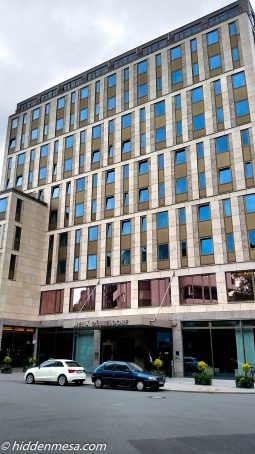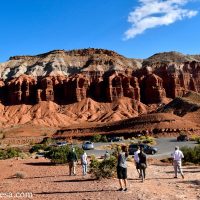Düsseldorf is one of the larger cities in Germany. Located in the western portion of the country, it’s the capital of the German Republic State of North Rhine-Westphalia, which borders Belgium and The Netherlands on Germany’s western boundary. Since 1949, Düsseldorf has been considered the fashion capital of Germany, which explains all the seriously high fashion clothing stores we saw when walking through the ultra-modern downtown districts, looking for coffee. There are a little over 500,000 people living in the city limits, with about 100,000 of them transplants from other than Germany, but mostly from around the European Union.

In the Altstadt, old town, there are many outdoor cafes along the Rhine River. Photo by Donald Fink.
There’s a vibrant Old Town along the Rhine River, where we spent some time wandering the shops and cafes. We found a great American style steak house called Block Steak House. It turns out that they’re a relatively large chain of restaurants with locations throughout Europe.
There was one Starbucks in town that we found. The Starbucks app lists one in Old Town, but it turns out that it’s closed, permanently. Interesting that the Starbucks app lists it as an open restaurant, but Google Maps lists it as closed.. Hmm. Still, we found another one that was open in a shopping mall in the Konigsallee fashion district, near the park, and less than a mile’s walk from our hotel.

Melia Düsseldorf is a very modern hotel, conviently located about 15 minute’s walking time to the Konigsallee shopping area or a 15 minute walk to Altstadt, Old Town, through the Hofgarten, Park. Photo by Bonnie Fink.
While in Düsseldorf, we stayed in a Melia Hotel. Melia is a European hotel chain that we’ve used before with good results. We use them for the same reasons we use Holiday Inn Express in the States. We get loyalty points, which leads to free nights and therefore reduced overall costs, and we also have an expectation of quality. At Melia in Dusseldorf, we found a relatively modern building with clean, large rooms. There was good internet in the rooms that was included with the price of the room. The restaurant served buffet style breakfast that was not automatically included in the room price, but available for a nominal fee. They also served dinner, but we didn’t sample evening meals, preferring instead to find our meals outside in one of the many close-by restaurants. Parking was an additional €25.00 per day. We would normally be annoyed at the parking price, but having just left New York City where the price to park (assuming you could live through a car ride to the hotel) was a staggering $70.00 per night! It made Dusseldorf seem like a bargain.
From our hotel, all destinations led through the Hofgarten, the oldest park in Germany. The first portions of the Hofgarten were built in the 18th century. We transited the Hofgarten on our way to the Old Town, and on our way to Starbucks in the Konigsallee Shopping Area. In each case, the walk was just under a mile, and we only made it through a tiny portion of the park. In terms of beauty, the Hofgarten isn’t Golden Gate Park in San Francisco, nor is it Central Park in New York City, but it does have its appeal. If we lived in Düsseldorf, we would no doubt spend a lot of time relaxing there.
Speaking of the Konigsallee, it’s a major upscale shopping district in the heart of Düsseldorf. It features world renowned clothing, jewelry, and just about every other fine shopping store you could want. It was a place where, if we needed a new pair of cuff links, we would certainly be able to find them, but we might have to think about the purchase awhile before committing the money. Of course, on this trip, we didn’t feel the need for new cuff links, so we just went to Starbucks.
We had a good few days in Düsseldorf. If we needed to go there again for some reason, it wouldn’t be the end of the world. We enjoyed it like we enjoy pretty much any big, busy city. We found the people to be polite and friendly. They seemed to be used to tourists and our language challenges. Actually, most people we encountered spoke English. It was just kind of surprising that most of the people we interacted with were not native German speakers, but imports themselves.
Can we recommend Düsseldorf for other travelers? Sure, we used it as a base for travel to other locations in the immediate area. Düsseldorf is in the middle of some interesting historic places, and getting in and out of town was generally easy. Traffic was not as challenging as you might expect for a reasonably large city. Of course, at just over half a million people, it really isn’t that big. We aren’t big city people by our nature, but we found it easy to navigate, safe, and comfortable.
On our way to a laundry mat, we happened to walk through an area that seemed to be just a local neighborhood, just for locals. It was filled with shops, cafes, grocery stores and so on. We were as comfortable in that area as we were in the more touristy areas.
Our plan for now is to not return to Düsseldorf in the near future. We visited, enjoyed this city, and now it’s time to move on.










